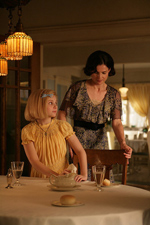Kit Kittredge is a spunky ten-year-old who is fiercely loyal to her friends, great at solving mysteries, and determined to become a reporter. If you have a daughter between the ages of six and eleven, you likely already know all that. Kit Kittredge: An American Girl is inspired by the Kit Kittredge books, which are based on one character in the wildly successful American Girl line of historically set dolls. But don’t let the connection between a movie and a doll franchise scare you. This film is artistically light years beyond Strawberry Shortcake cartoons or the nonsense that was Bratz: The Movie. In fact, the doll connection is in some ways unfortunate (despite the tween girl audience it guarantees), because, given a chance, this film will appeal to girls—and boys—of all ages.

Kit Kittredge is set in 1934 Cincinnati. Kit (Little Miss Sunshine‘s Abigail Breslin) is happily occupied with secret meetings of her Tree House Club, not to mention hours at the typewriter diligently working on stories she hopes to pitch to the local newspaper. All is well until the Great Depression begins showing up in the neighborhood. When a family next store to Kit loses their house to foreclosure, it becomes clear that this is one children’s movie determined to treat gritty subjects with non-patronizing realism.
Before long, Kit’s comfortable middle class life evaporates. Her father (played with all-American heart and everyman charm by Batman and Robin’s Chris O’Donnell) loses his car dealership and is forced to temporarily relocate to Chicago in search of work. Kit’s mother (Sabrina’s lovely Julia Ormond) keeps a brave and resourceful face, opening her home to a quirky assortment of boarders and, much to Kit’s initial chagrin, selling eggs and vegetables to help pay the mortgage.

Despite the hard times, Kit and her mother are still prone to taking in strays, including an abandoned basset hound named Grace and a pair of young hobos willing to work for food. When the Kittredge home is robbed and one of the hobos is unfairly incriminated in the crime, Kit and her friends hastily become ad hoc detectives to save the day.
Screenplay writer Ann Peacock (The Chronicles of Narnia: The Lion, The Witch and the Wardrobe) rather miraculously manages to keep things resoundingly sweet and wholesome without sugar coating realities like poverty, class injustice, and bigotry. Her cause is aided by a fine cast of veteran actors, who bring comedic chemistry to portrayals of the boarders at the Kittredge house. Stanley Tucci’s sardonic vaudeville magician, Jane Krakowski’s husband-hunting dance instructor, Joan Cusack’s befuddled mobile librarian, and Glenne Headly’s prudish and burdened mother all add depth and humor. Wallace Shawn (the villainous Vizzini in The Princess Bride) brings his signature lisping bluster to the role of the curmudgeonly newspaper editor, while young Willow Smith (daughter of Will and Jada Pinkett Smith) and Max Thieriot (showing the same acting chops and heart-throb potential he revealed in The Pacifier) make achingly winsome hobos. And, at the centre of this acting storm, Abigail Breslin meets expectations as a likeable and believable heroine.

The film has a warm, Rockwell-esque look and feel to it, no small feat considering director Patricia Rozema (Mansfield Park) reportedly had only 27 days of filming and a modest budget with which to recreate Depression-era Cincinnati. For the most part, Rozema manages to mine real pathos from the story without weighing the film down into too much melodrama. Occasionally the movie’s pacing does seem a touch uneven, languishing a bit in the moralistic parts and racing rather suddenly when the action-adventure plotline comes to the foreground. Even still, my six-year-old daughter remained mesmerized throughout the whole film.
Kit Kittredge has many of the classic ingredients of a successful family tale, including a heroine who achieves her dreams through hard work and perseverance, a group of kids who outsmart the adult villains, and a resoundingly happy ending. But the film’s most notable success is in the unusual themes it brings to the children’s table. In many respects, Kit Kittredge is about the ways people adapt, or don’t adapt, to new kinds of normal when life doesn’t turn out as planned. It’s also about finding identity in something other than your ability to earn or provide, a challenge that proves daunting for many of the fathers in the film. Most importantly, it’s about the power of love and relationship, and the refusal to let shame or disappointment estrange families in the midst of hard times. Who knew one little American Girl could teach all that?
Talk About It
Discussion starters- What parallels do you see (if any) between the Great Depression and the present day economy? Is there someone in your neighborhood who could use some extra help?
- Kit’s dad tells her that when life throws you an obstacle, you “can’t let it beat you.” Is there an obstacle currently defeating you? How might you overcome it?
- Kit’s dad almost loses his family over his own shame in not being able to bring them good news, but in the end it means so much more that he is present with them than that he can provide for them. Have you ever let a reluctance to reveal something about your situation cause you to become distanced from someone you love? Is there someone you need to simply be there for, regardless of the circumstances?
- Many of the people in Kit’s life prejudge others based on their financial status. Does that prejudice exist in your circles? How might you work toward eradicating it?
The Family Corner
For parents to considerKit Kittredge is rated G and is remarkably wholesome. There are a few scenes of mild peril likely to frighten only very sensitive young children.
Photos © Copyright New Line Cinema
Copyright © 2008 Christianity Today. Click for reprint information.











